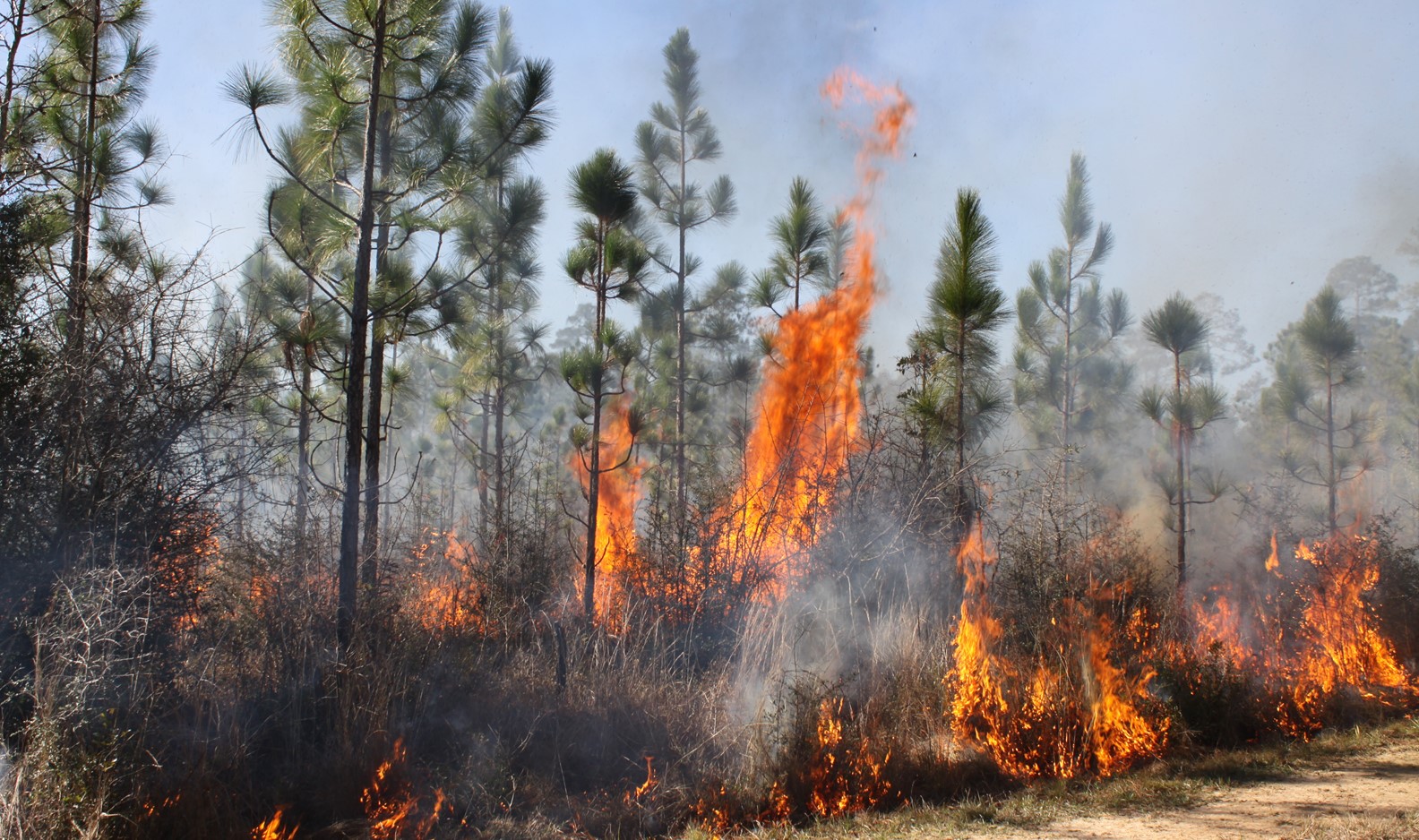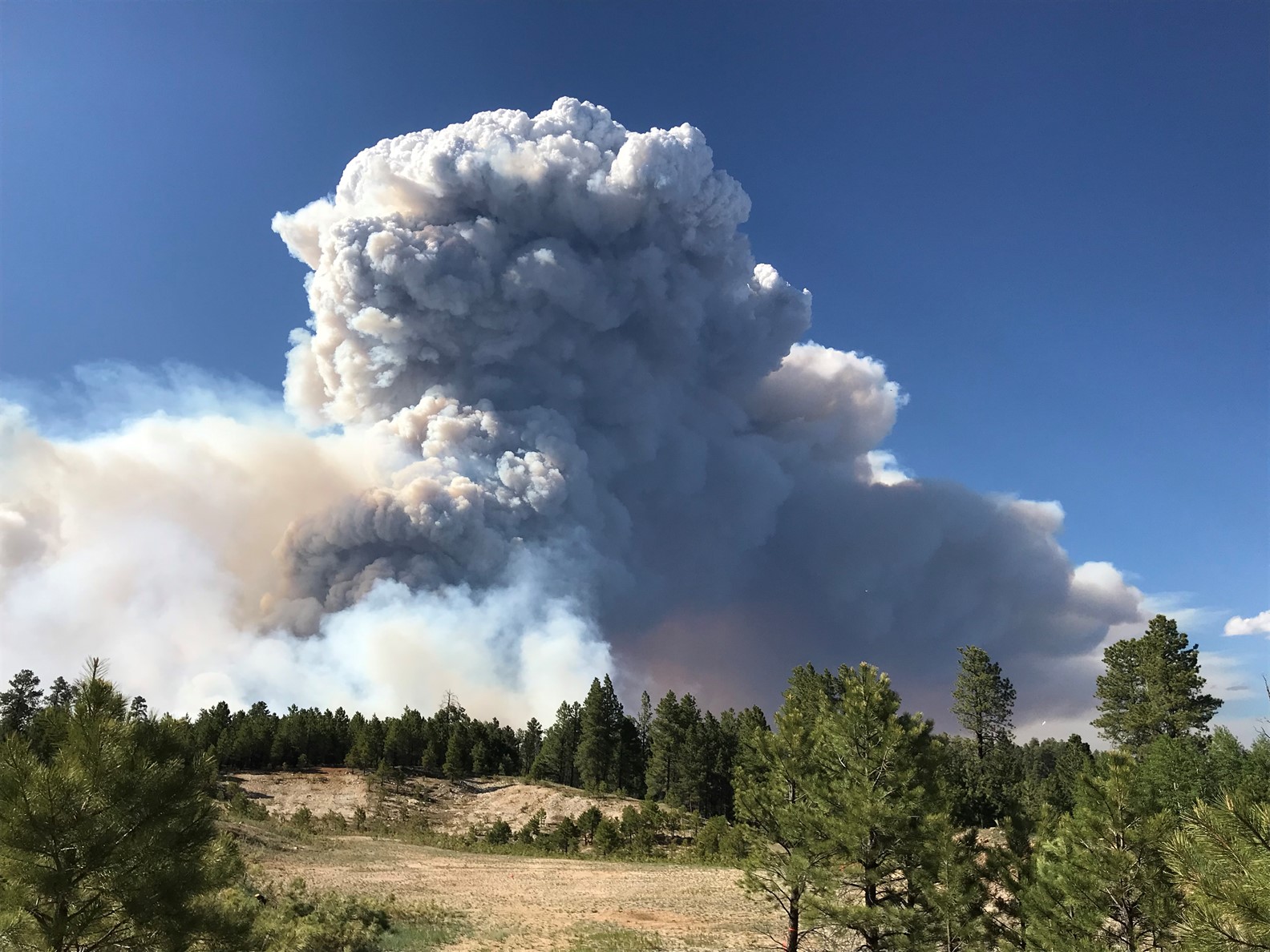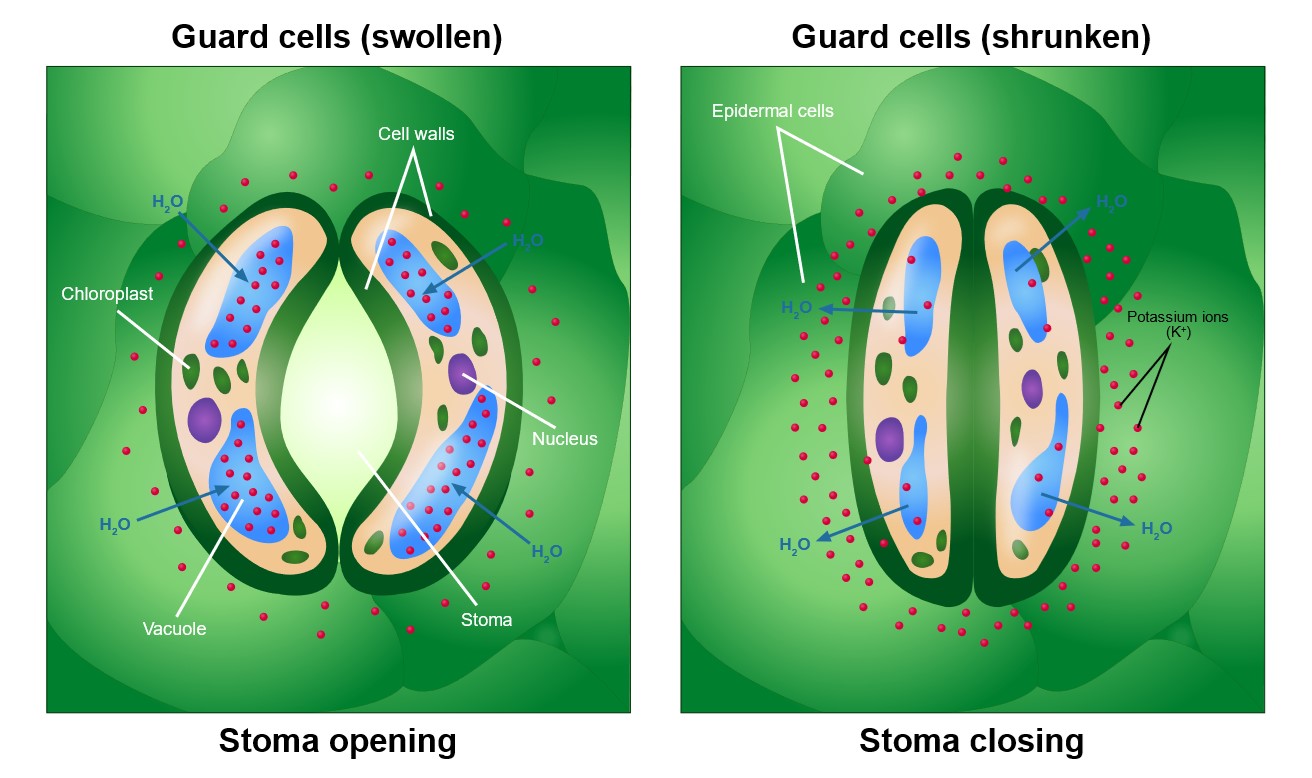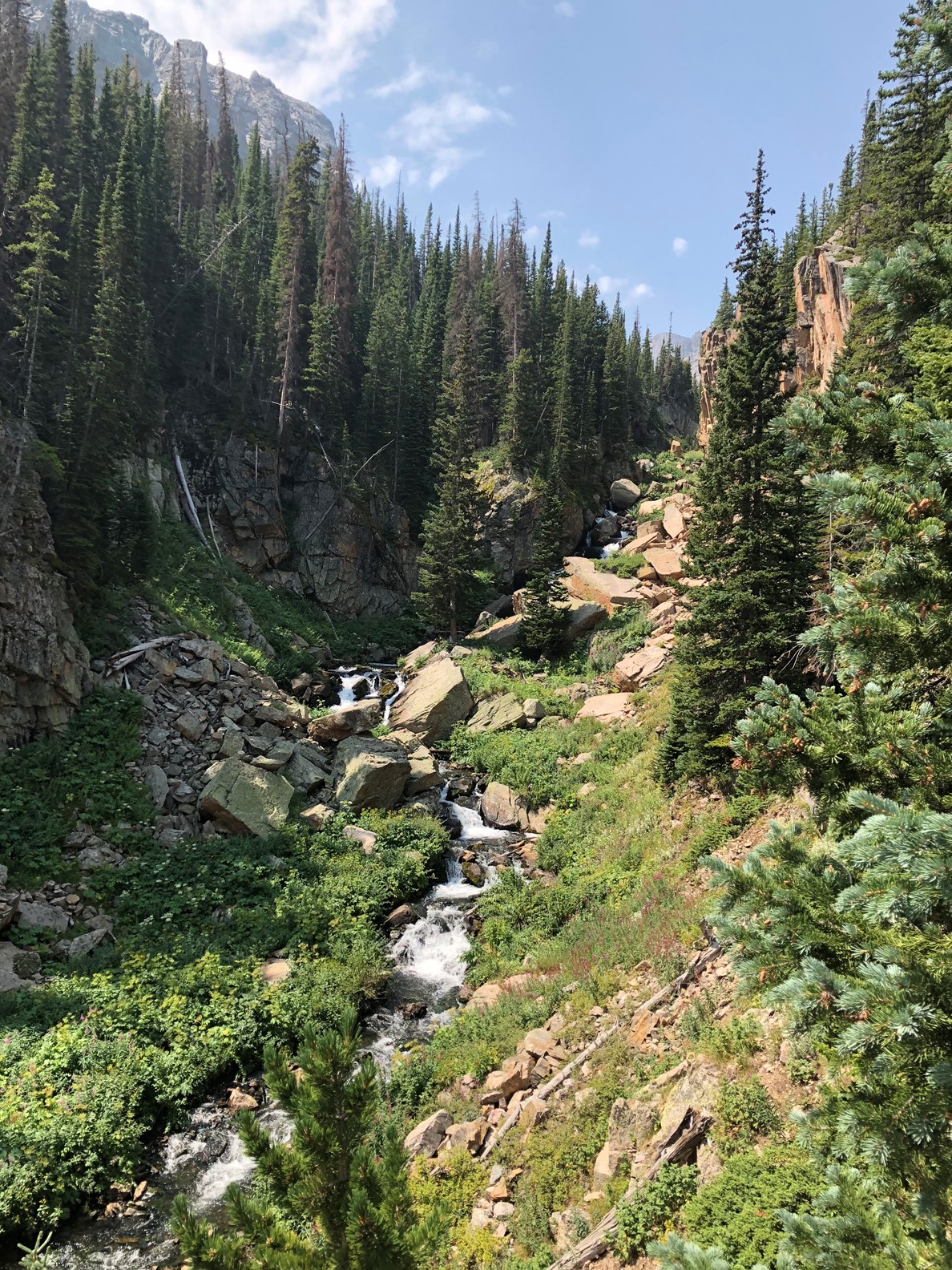
Credit: NPS Photo, public domain, via Wikimedia Commons
Background
Synopsis: Trees breathe by taking in carbon dioxide and releasing oxygen. A study during a wildfire in Colorado revealed that Ponderosa pine trees can temporarily halt this process when exposed to heavy wildfire smoke, potentially protecting themselves but at a cost to growth.
Trees Breathe
- Through the wonderous process of photosynthesis, trees and other green plants open pores known as stomata on their leaves and take in carbon dioxide. Carbon dioxide is food for plants and, when combined with water and sunlight, forms glucose (C6H12O6), the fuel needed to grow new cells and cellulose, and make new leaves, flowers and fruit.
- While trees and other plants that undergo photosynthesis use the glucose produced, the waste-product of photosynthesis, oxygen, is released into the atmosphere.
- EarthDate episode 284, How Trees Lift Water explains the process of photosynthesis in trees and how they get the water needed for this process as well.
Serendipity
- A group of scientists working in Colorado were studying the oxygen and other gases expelled by Ponderosa pine trees. They were hoping to learn more about the volatile organic compounds (VOCs) that these pines release that emit the familiar pine scent.
- VOCs can have these pleasant odors but are also considered primary air pollutants. When VOCs combine with nitrogen oxides and sunlight, ground-level ozone forms and could be a damaging unpleasant result of these emissions.
- The researchers had equipment set up to measure rates of photosynthesis and the concentration of VOCs when a wildfire erupted and sent smoke towards their test site.
- They were surprised to see that when the heavy smoke reached the area, the Ponderosa pines closed the stomata on their needles completely, halting the photosynthetic process.
- The release of the VOCs also dropped to very low readings compared to the previous measurement.
- With new conditions present, the scientists pivoted and began looking at a new research opportunity.

Wildfire smoke can travel hundreds of miles and affect the health of humans, animals, and plants.
Credit: Kabib National Forest, public domain, via Wikimedia Commons
Knowledge from the Past
- Perhaps unsurprisingly, there is research from over a century ago that explored the same topic.
- In 1914, A.L. Bakke from the Iowa Academy of Science studied the effect of coal smoke on conifers. He observed that these trees were more susceptible to damage from the coal smoke. He suggested that the “deeply sunken stomata” of the conifers became clogged by the black, tar-filled smoke from coal which blocked the exchange of gases.
- J.B. Rhine from the Hull Botanical Laboratory summarized the literature on the topic in 1924 and reported that the black deposit on the stomata was instead a natural wax produced by the plant itself. Additionally, the wax was fine-grained and permeable, so the exchange of gases would slow as would the passing of water.
- Some current research on crops and wildfire smoke suggests that plant photosynthesis may actually improve as a result of the diffusion of light when smoke is present.
- Another study from 2010 exposed both conifer and deciduous trees to smoke in a laboratory setting and then evaluated their response. They observed that the rate of photosynthesis did decrease for all types of trees, but the conifers recovered at a faster rate once the smoke was removed. They suggest that further research was needed to evaluate the types of gases in wildfire smoke and the variation of response in different plant types.

The movement of water and potassium ions into and out of the guard cells causes the stoma to open and close.
Credit: Ali Zifan, CC BY-SA 4.0, via Wikimedia Commons
The New Experiment
- Studying the effect of wildfires on plants is challenging since wildfires are unpredictable and dangerous and few experiments have access to field research. The team from Colorado was in the process of a multi-year study on photosynthesis and happened to be in the right place at the right time.
- Using a portable photosynthesis system device along with equipment capable of measuring trace gases, the team was able to gather precise data on the absorption and emission of gases in the pines.
- The device can be calibrated for varying levels of light, temperature and humidity which is important in controlling the variables in a field study, especially during the quickly changing conditions present during a wildfire event.
- The measurements verified the research of others that the electrical conductance of the stomata regulates photosynthesis. Either wildfire particles or gases deposited near the pores caused them to be blocked and reduce the rate of photosynthesis.
- An attempt to “revive” the leaves by flowing an ideal mix of air at 25°C and 50% relative humidity did not entice the stomata to open and photosynthesis to return.
- However, the stomata did open when the temperature was increased to 40°C or when the humidity was dropped to 5%. When this was carried out, they saw a burst of VOCs from the plant.
- After collecting data on 16 different VOCs during the impromptu experiment, they proposed several possible mechanisms for the occlusion or closing of the stomata, most involving either physical or chemical changes to guard cells that flank the stomata opening.
- There was not enough time or resources to replicate the experiment given the variable nature of the wildfire and smoke, however the study is still very worthwhile in providing in situ data on leaf smoke exposure.
Impact and Implications
This study sheds light on the resilience and vulnerability of trees during wildfire events.
- Heavy smoke from wildfires significantly reduces how much carbon dioxide trees can absorb through photosynthesis. Based on data from NOAA, the scientists estimated that in years with numerous smoke-filled days, like those during the study, the growth of ponderosa pine forests may slow down by 7% to 14%.
- While trees may "hold their breath" as a survival strategy, the long-term ecological and economic impacts of reduced growth rates are significant. Understanding these dynamics will be crucial as wildfires shape forest ecosystems worldwide.

A pine forest in Rocky Mountain National Park in Colorado.
Credit: Lynn Kistler
Episode script
Scientists studying Ponderosa pines in a Colorado forest were interrupted by a wildfire – which led them to a surprising discovery.
The researchers were investigating the trees’ photosynthesis, during which they take in CO2 through pores in their needles, called stoma.
When heavy smoke from the wildfire filled the forest, the scientists had their equipment in place and operating, and witnessed something unexpected: the trees held their breath. They closed their stoma, apparently to stop the smoke from entering.
The scientists combed past research for something similar, and found a study from 100 years earlier, that showed coal smoke caused a different species of pine to produce a semi-permeable pitch blocking their stoma, to exclude the smoke while still allowing some CO2 to enter.
In both cases, reduced CO2 meant reduced photosynthesis…which meant the trees produced less glucose.
Glucose powers the growth of new wood -- and new needles to conduct more photosynthesis. So, when the trees close their stoma, it slows growth.
Other scientists estimated that the trees’ growth rate during these smoky conditions fell by up to 15% -- as they traded growth for protection from smoke.
Clearly, over millions of years of evolution, this has proven a successful strategy. Understanding it will help scientists better predict how forests may be shaped by wildfires in the future.

